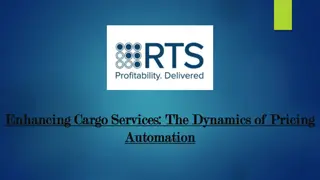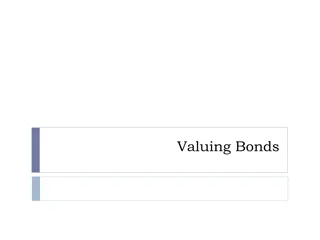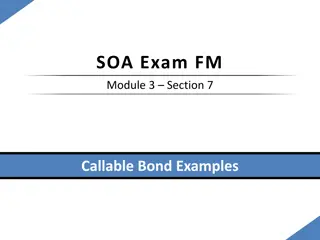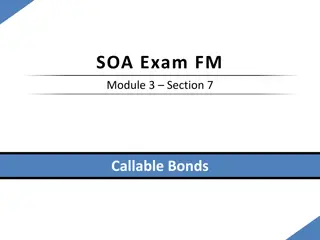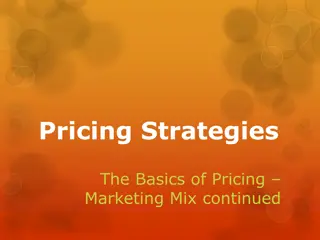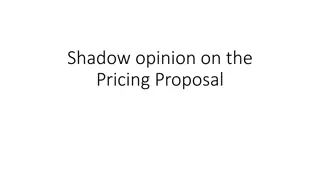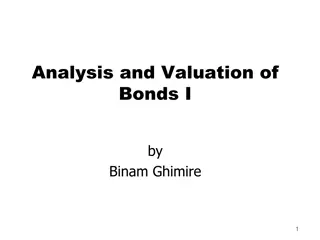Understanding the Bond Market: Maturity, Yield, and Pricing
Financial markets facilitate borrowing and lending, influencing interest rates, stock prices, and bond prices. Bonds promise future payments in exchange for current prices, while stocks offer ownership rights and dividends. The bond market involves maturity dates, coupon rates, and yield to maturity calculations. Present value and computing yields on bonds are crucial for investors to determine profitability. Understanding how bond prices and yields are interconnected helps investors make informed decisions in the bond market.
Download Presentation

Please find below an Image/Link to download the presentation.
The content on the website is provided AS IS for your information and personal use only. It may not be sold, licensed, or shared on other websites without obtaining consent from the author. Download presentation by click this link. If you encounter any issues during the download, it is possible that the publisher has removed the file from their server.
E N D
Presentation Transcript
Financial Markets Financial markets link borrowers and lenders. determine interest rates, stock prices, bond prices, etc. Bonds a promise by the bond-issuer to pay some specified amount(s) in the future in exchange for some payment (the bond price) today. Stocks (equities) legal rights of ownership in an incorporated firm. promise the stockholder a share of the corporte profits (dividends)
The Bond Market. Maturity date: the specific future date on which the maturity value will be paid to the bond holder. Bond maturity dates generally range from 3 months up to 30 years. Coupon rate Between the date of issuance and the maturity date, the bond-holder receives an annual interest payment equal to the coupon rate times the maturity value. Yield to maturity represents the effective interest rate that the bond-holder earns if the bond is held to maturity. Bond price The price that the bond sells for. This fluctuates over the life of the bond. If the bond price is equal to 100% of its maturity value, the bond sold at par . If the bond price is below 100% of its maturity value, the bond price sold below par .
The Bond Market 20 year bond with maturity value of $1000 and coupon rate of 5% promises 20 annual payments of .05*1000=$50 $1000 payment at maturity (20 years from now). If price is $1000 for this bond, the bond sold for par.
Present Value PV of $X to be paid in T years Amount that if deposited today would grow to $X in T years $X/(1+r)T Example: $100 deposited today at 10% interest will grow to: $100(1.1) in 1 year $100(1.1)2 in 2 years $100(1.1)3in 3 years $100(1.1)T in T years i.e. (FV) Future value of x deposited today for T years =PV(1+r)T (compounding interest) Rearrange above equation to solve for x PV of x to be received in T years = x/(1+r)T (discounting)
The Bond Market. Computing yields on a bond. The yield on a bond is the same as the internal rate of return. To calculate the yield to maturity, define net present value (NPV) as follows: NPV = CP1/(1+r) + CP2/(1+r)2+ .... + CPT/(1+r)T+ MV/(1+r)T- P CP1, CP2, ... CPTare the interest or coupon payments in periods 1 through T MV is the payment received at maturity P is the price paid for the bond. The yield to maturity is the interest rate that makes the NPV on the bond purchase zero.
The Bond Market. One year bonds NPV = MV(1+cr)/(1+r) - P where cr is the coupon rate. Setting NPV=0 and solving for r provides the yield to maturity: yield = [MV(1+cr)/P] - 1 As the price paid for a bond increases, the yield on the bond falls. If P=MV (i.e. pay par), yield=CR If P>MV, (i.e. pay above par), yield<CR If P<MV, (i.e. pay below par), yield>CR
The Bond Market. Zero Coupon Bonds. With zero coupon bonds, no interest payments are made between the sale of the bond and its maturity. That is, there is a zero coupon rate. For such bonds, the yield calculations is straightforward. NPV = MV/(1+r)T- P setting NPV=0 and solving for r provides the yield: yield = (MV/P)1/T- 1 For example, if you buy a zero coupon bond today for $1000 and it has a maturity value of $1500 in 10 years: yield = (1500/1000)1/10-1 = .0414 = 4.14% As the price paid for a bond increases, the yield on the bond falls.
The Bond Market. Determinants of bond yields Higher expected inflation will drive up yields. Higher risk bonds must offer higher yields. Default risk. Inflation risk Term Longer term bonds have greater inflation and default risk.
The Bond Market. Yield curve relationship between yield and term on government bonds Slope of yield curve reflects Expectations of future short term interest rates Greater risk of long term bonds If short term interest rates are expected to be constant in the future, yield curve will slope upward reflecting risk premia for longer term bonds. A steepening of the yield curve suggests that financial markets believe short term interest rates will be rising in the future. The dynamic yield curve (see link on web page)
The Stock Market Stocks (equities): legal rights of ownership in an incorporated firm. promise the stockholder a share of the corporte profits (dividends)
The Stock Market The fundamental value of a stock is the expected present value of all future dividends from a stock. P = d1/(1+r) + d2/(1+r)2+ d3/(1+r)3+ ....dT/(1+r)T where T is the end of the firm s life (which might be infinite) d1, d2, ... dTrepresent dividend payments in years 1 through T. r is the interest rate
The Stock Market Given the fundamental value theory, stock prices will rise with: lower interest rates. an increase in future expected dividends. A lower tax rate on dividends.
The Stock Market Efficient markets hypothesis: All stock prices represent their fundamental value at each point in time. When new information arrives about a stock, its price immediately adjusts to reflect that new information. It is impossible to consistently predict which way a stock price will move in the future and to consistently beat the market .
The Stock Market. If the efficient markets hypothesis is true, financial advisors can assist you only in evaluating the risk and tax consequences of different stocks and concerns regarding income or growth, etc. Financial advisors will not be able to consistently find stocks that will beat the market . The validity of the efficient markets hypothesis is controversial among financial economists.
The Stock Market Stock quotes (see, for example, Price Volume (number of shares sold in previous day) EPS (earnings per share) PE ratio (price-earnings ratio) Beta (measures stock movements relative to market) See finance.yahoo.com for stock quotes
Mutual Funds Mutual Funds: a firm that pools money from many small investors to buy and manage a portfolio of assets and pays the earnings back to the investors. Mutual funds can be categorized in several ways. For example: index funds (S&P 500 or Willshire 5000) international funds (invest in foreign securities) bond funds (invest in bonds) money market funds (invest in short term government securities) The major advantage of mutual funds is that it allows a person to invest in the stock market and be diversified.
Futures Market A market for contracts that provide for future delivery of a good at some pre-specified price. commodities, bonds, and foreign currencies. A 1/1/2014 futures contract to buy 1000 bushels of corn at $3.00 per bushel Buyer is committed to buying corn on that date at that price. Seller is committed to selling corn on that date at that price. If the expected price of a commodity in the future rises, the futures price will rise. The price in futures contracts provides an indicator of what people believe about the movement of prices in the future.






